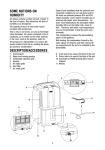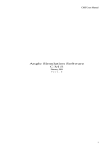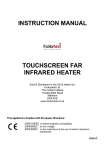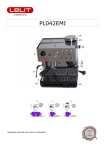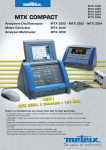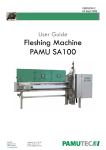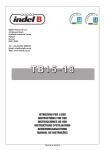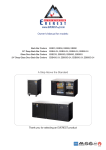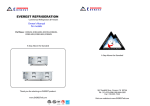Download Instruction manual
Transcript
ge caused by condensation.
Experts have established that the optimum environmental conditions for our well being and for
the home are obtained between 40% and 60%
relative humidity. With very low temperatures,
you are recommended to heat the room even
minimally.
This considerably increases the dehumidifying
power of the appliance.
With heating, the condensation formed by the
water vapour on windows and other cold surfaces
evaporates into the air to be collected by the
dehumidifier. Air leaving the dehumidifier is
usually about 1°C warmer than room temperature.
SOME NOTIONS ON
HUMIDITY
Air always contains a certain amount of water in
the form of vapour. This determines the level of
humidity in an atmosphere.
The capacity of the air to hold water vapour
increases with temperature.
This is why in our homes, as soon as the temperature decreases, the vapour contained in the air
condenses, as is evident on the colder surfaces in
the room, such as the windows, walls etc.
The purpose of a dehumidifier is to remove the
excess moisture from the air, avoiding the dama-
DESCRIPTION/ACCESSORIES
1.
2.
3.
4.
5.
Control panel
Water level viewing window
Condensate collection tank
Lifting handle
Air intake grille
6. Silver ion air filter
7. Air outlet grille
8. Condensate drain hose (2 m)
9. Castors
10. Continuous drain connector (certain models
only)
4
1
5
6
10
8
7
2
3
9
10
INTRODUCTION
SAFETY
Thank you for choosing a De'Longhi product.
Take a couple of minutes to read these instructions.
This will avoid danger or damage to the appliance.
Fundamental safety warnings
GB
Danger! This is an electrical appliance, it
is therefore important to respect the following
safety warnings:
• Do not touch the appliance with wet hands.
• Do not touch the plug with wet hands.
• Make sure the mains socket used is always
accessible, enabling you to unplug the
appliance when necessary.
• Always unplug the appliance using the plug
itself.
Never pull the cable as it might be damaged.
• To disconnect the appliance completely from
the electricity supply, you must unplug it from
the mains socket.
• If the appliance malfunctions, do not attempt
to repair it.
Turn the appliance off, unplug from the mains
socket and contact a Service Centre.
• Do not move the appliance by pulling the
power cable.
• It is dangerous to modify or alter the characteristics of the appliance in any way.
• If the power cable is damaged, it must be
replaced by the manufacturer or an authorised
technical service centre in order to avoid all
risk.
• Do not use extension leads.
• The appliance must be installed in accordance
with the rules on household appliances in
force in the country concerned.
• The appliance must be connected to an efficient earth installation.
Have your electrical circuit checked by a qualified electrician.
Symbols used in these instructions
These symbols draw your attention to important
warnings.
It is vital to respect these warnings.
Failure to do so may result in electric shock,
serious injury, burns, fire or damage to the
appliance.
Danger!
Failure to observe the warning may result in life
threatening injury by electric shock.
Important!
Failure to observe the warning may result in injury
or damage to the appliance.
N.B.:
This symbol draws your attention to important
recommendations and information.
Problems and repairs
In the event of problems, first try and resolve
them by reading the information given in the
"Troubleshooting" section on page 9.
If the appliance requires repair, always contact a
Service Centre authorised by the manufacturer.
Always insist on original spare parts. Repairs carried out by unauthorised personnel may be dangerous and invalidate the guarantee.
Important! Keep packaging materials
(plastic bags, polystyrene foam) out of reach of
children.
Important! The appliance is not intended
for use by persons (including children) with reduced physical, sensory or mental capabilities, or lack
of experience and knowledge, unless they have
been given supervision or instruction concerning
use of the appliance by a person responsible for
their safety. Always supervise children. Make sure
they do not play with the appliance.
11
Appropriate use
The appliance is designed and produced for
domestic use only.
Use this appliance only as described in this
instruction manual.
As with all electrical equipment, whilst the instructions aim to cover as many eventualities as possible.
caution and common sense should be applied
when operating and installing this appliance.
•
•
Electrical connections
General safeguards
•
•
•
•
•
•
•
•
•
•
If the appliance is transferred to other owners,
they should also be given these instructions.
Failure to respect the instructions may result
in injury or damage to the appliance.
The manufacturer is not liable for damage
deriving from failure to follow these instructions.
Keep the list of Service Centres and identify
the Centre nearest you.
After moving the appliance, wait at least an hour
before turning it on again.
Before plugging the appliance into the mains socket, check that:
• The mains power supply corresponds to the
working voltage indicated on the rating plate.
• The power socket and electrical circuit are
adequate for the appliance.
• The power socket matches the plug. If this is
not the case, have the plug replaced by a qualified electrician;
• The mains socket is adequately earthed.
Do not install the appliance in rooms containing gas, oil or sulphur. Do not install near
sources of heat.
Do not use the appliance on sloping surfaces.
Keep the appliance at least 50 cm away from
flammable substances (alcohol etc) or pressurised containers (e.g. aerosol cans).
Do not rest heavy or hot objects on top of the
appliance.
Always transport the appliance upright or
resting on one side.
Remember to drain the condensate tank before moving the appliance.
Wait at least 1 hour after transporting the
appliance before starting it
R134a refrigerant complies with European
environmental standards. However, you
should avoid perforating the refrigerant circuit.
At the end of its working life, consign the
appliance to a specialist collection centre.
ENVIRONMENTAL INFORMATION:
This unit contains fluorinated greenhouse
gases covered by the Kyoto Protocol.
Maintenance and disposal must be carried out
by qualified personnel only (R134a,
GWP=1300).
The materials used for packaging can be recycled.
You are therefore recommended to dispose of
them in special differentiated waste collection
containers.
Do not use the appliance outdoors.
Do not obstruct the air intake or outlet.
Do not use the appliance in laundry rooms.
Instructions
Read these instructions carefully before installing
and/or using the appliance.
• Keep these instructions carefully.
12
INSTALLATION
in figure 4.
4) Make sure the end of the hose is no higher than
the spout or water could remain in the tank.
Make sure there are no kinks in the hose (Fig. 5).
Position the appliance in the room to be dehumidified. A free space of at least 50 cm must be left
at the front of the dehumidifier, so as not to block
the air outlet. For efficient ventilation a space of
about 5-10 cm should be left at the back of the
appliance. The condensate can be drained in one
of the following ways:
Nota Bene: Keep the rubber bung to close
the spout.
fig. 5
A) Draining into the tank
The condensate can be drained directly into the
tank. The tank can be easily removed (fig.1).
NO
NO
YES
fig. 1
Instructions for fitting the castors
B) Continuous external draining
1) Unplug from the mains socket and empty the
tank (if full)
2) Remove the rubber caps from the bottom of
the appliance by pulling forcefully or using
pliers (see figure 6/1).
3) Fit the castors by inserting the pins into the
holes. (see figure 6/2)
If the appliance is to be operated for long periods
but you are unable to empty the tank regularly,
you are recommended to use the continuous
drain facility.
1) Remove the continuous drain cap by turning
it anticlockwise then remove the rubber bung
from the spout (fig. 2).
2) In models with continuous drain, screw on
N.B.: While fitting the castors, do not tilt the
appliance at an angle of more than 45°. After
fitting the castors, wait for at least an hour
before using the dehumidifier again.
b
a
fig. 3
fig. 4
1
2
the connector as shown in figure 3. Make sure
the gasket in the connector is positioned correctly.
3) Attach the rubber hose to the outlet as shown
fig. 6
fig. 2
13
GB
HOW TO DEHUMIDIFY
Display
Display
Pulsantehumidity
Increase
incremento umidità
button
DecreasePulsante
humidity
button
decremento umidità
Pulsante
Fan button
Pulsante
Fan
Hygrometer/
termometro/igrometro
thermometer button
MODE button
ON/Standby
buttonby Pulsante
Pulsante
ON/Stand
MODE
Description of buttons
Display
Meaning of the codes or symbols which may be
displayed:
ON/Standby" button
ON/Standby" button
--
"MODE" button
Selects the operating modes: dehumidifying, dry,
smart and fan
Indicates that the appliance is in standby
mode.
Indicates that the tank is full, absent or
positioned incorrectly.
Indicates that the appliance is operating at
low temperatures. In this situation, ventilation cycles are alternated with dehumidification cycles to avoid the formation of
ice. For use in particularly cold environments, you are recommended to heat the
room to raise the ambient temperature
even minimally. This allows the dehumidifier to operate in conditions that improve its performance and accelerate the
dehumidifying process.
"Fan" button
Selects fan speed
Hygrometer/thermometer button
Temporarily displays the temperature and humidity measured in the room by the appliance.
N.B.: the measurements displayed are indicative
only.
Humidity increase/decrease buttons
Adjusts the percentage of humidity present in the
room, increasing it or reducing it by steps of 5%.
Indicates that there may be a fault with the
probes, or that the humidity in the room is
too low to be measured.
14
MODE SELECTION
Fan mode
1) Plug the appliance into a mains socket.
2) "- -" is displayed to indicate that the appliance
is in standby and therefore ready for operation.
If
is displayed, empty the tank or position it correctly.
3) Press the ON/Standby
button.
Press the "MODE" button and choose fan mode
("
" is displayed).
Press the "
" button to select the required fan
speed (MIN/MAX).
Dehumidifying mode
Press the "MODE" button and choose dehumidifying mode.
"
" and the level of relative humidity previously
set are displayed.
Press the "+" or "-" button to set the desired humidity (30% means a dry environment, 80% a
humid environment).
Press the "
" button to modify fan speed
(MIN/MAX).
When MAX speed is selected, the appliance operates at maximum dehumidifying power.
When MIN speed is selected, the appliance operates at low power and the noise will also be less.
Press the
button to display room temperature ("
" symbol) and the relative humidity
("
") in the room in sequence.
When the appliance reaches the set level of humidity it will stop and the fan will come on at regular
intervals to maintain a correct relative humidity
reading.
As soon as the humidity increases above the set
point, the appliance will automatically resume
dehumidification operation.
Dry mode
In Dry mode, the appliance operates constantly at
maximum power.
This mode is useful to dehumidify the room
rapidly.
Press the MODE button and choose Dry mode
(
symbol on).
Relative humidity and fan speed cannot be set.
Smart mode
This dehumidifies automatically.
According to room conditions, the appliance automatically establishes the optimum settings for
maximum comfort.
Press the MODE button and choose Smart mode.
The "
" symbol appears on the display.
Relative humidity and fan speed cannot be set.
15
GB
CLEANING AND
MAINTENANCE
After washing the filter, allow it to dry completely before repositioning it.
The silver ion filter not just retains dust particles, but also has an efficient antibacterial
action. It also greatly reduces concentrations
of irritants such as pollen and spores.
Always unplug the appliance from the power socket before performing any cleaning or maintenance operations.
For safety reasons, never wash the dehumidifier
using a jet of water.
If the appliance is not used for long
periods
Cleaning the cabinet
•
•
•
•
Clean the appliance using a damp cloth then
dry with a dry cloth.
Do not use petrol, alcohol or solvents to clean
the appliance.
Do not spray liquid insecticide or similar products as they may deform the plastic.
•
•
After unplugging the appliance from the
power socket, empty the tank.
Clean and reposition the filter.
Cover the appliance with a plastic bag to protect it from dust.
TECHNICAL SPECIFICATIONS
Cleaning the silver ion air filter
Power supply voltage
Absorbed power
Maximum power input
Freeze protection device
Hygrometer
Fan speeds
Air filter
Dimensions HxLxD
Tank capacity
If the filter is dirty, air circulation is compromised
and the efficiency of the dehumidifying and air
purifying functions decreases.
It is therefore good practice to clean the filter at
regular intervals. The frequency depends on the
duration and conditions of operation.
If the unit is used constantly or systematically,
you are recommended to clean the filter once a
week.
• Remove the air filter by pulling sideways (Fig.
7).
See rating plate
“
“
Yes
Yes
2
Yes
485x375x190
3 litres
fig. 7
Operating limits:
temperature
relative humidity
•
Important information for correct disposal of
the product in accordance with EC Directive
2002/96/EC.
At the end of its working life, the product must not be disposed of as urban waste.
It must be taken to a special local authority differentiated
waste collection centre or to a dealer providing this service.
Disposing of a household appliance separately avoids
possible negative consequences for the environment
and health deriving from inappropriate disposal and
enables the constituent materials to be recovered to
obtain significant savings in energy and resources.As a
reminder of the need to dispose of household appliances separately, the product is marked with a crossed-out
wheeled dustbin.
Use a vacuum cleaner to remove dust accumulations from the filter.
If the filter is very dirty, rinse well in warm
water.
The temperature of the water must not exceed
40°C.
16
2°C-32°C
30-90%
TROUBLESHOOTING
Check the following points before calling your local authorised Service Centre.
GB
PROBLEMS
The appliance is operating in
dehumidifying mode, but the
humidity does not decrease.
CAUSE
SOLUTION
The filter is blocked.
Clean the filter.
The temperature or humidity
in the room are too low.
In certain conditions, it is normal for the appliance not to
dehumidify (in certain cases,
it is recommended to heat the
environment).
The room is too big for the
dehumidifying power of the
appliance.
Too many sources of humidity
in the room (pots of boiling
water, etc.).
The humidy set point is too
high.
Decrease the humidity set
point.
The safety device has tripped.
Wait for 3 minutes to pass.
The tank is missing.
Replace the tank.
The tank is full.
Empty the tank.
The tank is incorrectly
positioned.
Position the tank correctly.
is displayed
The temperature in the room is
very low.
Increase room temperature.
is displayed
One of the sensors on the
appliance is faulty or the humidity in the room is too low or
too high to be measured correctly.
See if the appliance starts working again when moved into
another room with a level of
humidity within the operating
limits indicated in the
"Technical Specifications" section. If the problem persists,
call the Service Centre.
The appliance does not
work for 3 minutes after
start-up.
is displayed
17









